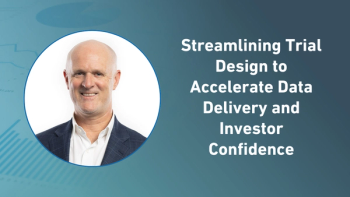
Applied Clinical Trials Supplements
- Supplements-05-02-2007
- Volume 0
- Issue 0
Oncology Trials and Drugs: A Unique Therapeutic Areas?
When it comes to R&D all drugs are not created equal, especially oncologics. And an ACT workshop counts the ways.
For a long time, drug development has been dominated by the urge to find yet a better drug to treat hypertension, hypercholesterolemia or heartburn. Big pharma companies were competing in the major primary care markets. And today, for every indication, more than a handful of blockbuster drugs are available. But now that reimbursement is more of an issue, with many generic products on the market featuring comparable effects, the industry has changed its focus toward more specialized care, like oncology.
Cancer is still a frightening thought for most people. The search for cancer medicines usually gains the support of the public, even with their rather hostile attitude toward pharmaceutical companies. Until recently, however, the number of drugs developed for cancer treatment was rather limited. Since the discovery of Nitrogen mustard derivates and the anthracyclines, it has been relatively quiet. This may be attributed to the suggestions that cancer drug development is complex.
The question of whether oncologic drug development is truly different from the development of primary care medicines was discussed during a workshop at the European ACT Summit in the Fall of 2006. The reasons for the relative absence of new oncologic drugs was discussed, based on the statement: Cancer is a rare, lethal, and complex disease that is not profitable for the industry, as drugs require a different development approach.
Figure 1. Worldwide lung cancer incidence in men.
A rare disease
The incidence of cancer varies enormously across the world. The age-adjusted incidence of breast cancer in China and India is 19 per 100,000 females; that number jumps to 101 in the United States. Similar differences across the world can be found for colorectal and lung cancer. Despite the numbers, incidences of cancer can be considered low when compared to hypertension, heartburn, COPD, and other diseases or conditions.
The incidence of hypertension is not always well documented, but it is at least 300 per 100,000 persons; the prevalence is thought to be much higher and may even reach 30% in elderly patients.1,2 Clearly, this condition is of a different magnitude than cancer when compared to the individual types of tumors. Even when adding up the major cancer types like breast, lung, and colon, the total incidence rate per 100,000 persons is below the rate of common diseases and, thus, relatively rare.3,4 However, when realizing that in many developed countries one in 10 women will be confronted with breast cancer, one cannot call this a rare disease.
Figure 2. Worldwide female lung cancer incidence.
In addition, most cancers have shown a gradual increase in incidence over the past few years, which implies that cancer is a growing problem.
A lethal disease
Cancer is still associated with death by the public. It is probably the most feared message from a physician. The question is whether this is realistic.
Worldwide, cancer is definitely not the most frequent cause of death. In developing countries infections are responsible for the vast majority of deaths. AIDS, malaria, and other more general infectious diseases kill almost 10 million people a year. In the industrialized world, cardiovascular diseases are the major cause of death. Myocardial infarctions, hypertension, cerebrovascular events, and heart failure kill over 7.5 million people a year.5 In this respect, cancer still plays a relatively minor role. Lung and stomach cancer together cause the death of about 1.5 million people, the other types of cancer considerably less. From a magnitude perspective, cancer is not a lethal disease—but what about the people who actually have it?
Over the past few decades, cancer survival rates have significantly increased. Overall, more than half of all patients survive more than five years. But there is considerable variation among the different types of cancer. Whereas more than 80% of all patients with skin cancer survive for more than five years, survival is only about 10% for those with esophagus cancer.
It is important to realize that the increase in cancer survival rates is largely attributable to a few relative frequent cancer types like breast and prostate cancer. For these cancer types, screening programs for early detection have been implemented and there are more treatment opportunities. Compared to other diseases, cancer is still a very serious deadly disease. Fortunately, recent improvements have dramatically improved patient outcomes.
An unprofitable disease?
Some claim that one reason for the relative absence of oncology drugs is that they are not profitable for pharmaceutical companies. But is this claim true?
In 2001, the best-selling oncology drug was the LHRH analog goserelin, with estimated sales of over $1 billion. It ranked 82 on the top 100 list of best selling drugs, along with docetaxel and oxaliplatin—the only other oncologic drugs on the list. In 2005, docetaxel was ranked 34, and three other oncologic blockbusters made the top 50 list. Many new oncology drugs have recently entered the market, which means increased revenues for the companies.6,7
So, oncology drugs have shown to be beneficial for both patients and industry. Clearly the industry has become aware of this. Almost all major pharmaceutical companies are now focused on oncology drug development. As a result, over 400 new oncology drugs are in clinical development. Still, the number of new oncology drugs that reach the market is relatively modest. This may have to do with the nature of the disease.
Complex and difficult
There is no such thing as one disease called cancer. Cancer is just a synonym for a large number of diseases characterized by uncontrolled cell growth. The cause of this loss of control can be very diverse, even within cancers of the same organ. Loss of cell growth control can be caused by loss of control mechanisms that suppress growth. Mutations in so-called tumor suppressor genes can result in loss of growth control, which in turn may result in cancer. On the other hand, cancer may be caused by excessive stimulation of certain pathways.
Although this may sound relatively easy, the truth is far more complex. Within one patient a tumor often carries cells with different types of deregulations, characterized by different mutations. This may explain why only a percentage of patients benefit from a treatment even though they all have the same cancer type. All this proves that cancer is complex. The question is whether this is the case for other diseases.
The fact that cancer therapies were toxic and often could not be tolerated forced science to better understand the background and cause of the disease. Molecular biology proved instrumental in this research, which revealed the different signaling pathways that we now know. But it would be naïve to assume that cancer is the only disease in which these genetic defects play a significant role. It was not until very recently, however, that researchers began looking at this correlation. That's because as long as antihypertensive drugs work in the majority of patients without causing bad side effects, their underlying molecular mechanisms are not as interesting.
Also, in nononcologic therapeutic areas understanding the molecular biology of the disease increases; thus, the chances of developing specific targeted drugs increase.
Oncology drug development
All the previous hypotheses have lead to the discussion of drug development in oncology. As mentioned, classical chemotherapeutics require a different approach compared to conventional drugs, but there are more distinct differences.
Unlike conventional drugs, most oncology drugs cannot be tested in healthy humans. It simply would not be ethical to expose healthy people to highly toxic drugs that could potentially be lethal. Some drugs act on specific targets in cancer cells only or, like aromatase inhibitors, have different pharmacokinetics/pharmacodynamics in cancer patients compared to noncancer patients. This makes it very complicated and even impossible to first test these drugs in healthy volunteers. Therefore, first-in-man trials are usually performed with patients that have no other therapeutic option left. When all available conventional therapies fail, many patients are prepared to take a risk for a small chance of success.
To limit patients' exposure to doses too low to be effective, only a very small number of patients per cohort are treated. It is always highly frustrating to realize that several patients will likely be exposed to doses too low to be effective; on the other hand, the recent Tegenero incident proves that one cannot be careful enough. That also is the reason why most Phase I and Phase II oncology trials are performed in highly specialized hospitals that are fully equipped and staffed and not in CRO research centers. Conventional drugs are usually tested in healthy volunteers, as toxicity is usually limited and predictable. Safety is still an issue, but treated subjects are in good condition and a specific treatment effect is expected.
In the era of new, targeted drugs there is yet another dilemma. Oncology drugs act primarily by inhibiting a deregulated pathway, which indirectly leads to cell death. These are the classical cytotoxic drugs. But what is the optimal dose for such drugs? The maximum tolerated dose? The minimum dose that leads to maximum inhibition of the target?
Drugs like imatinib and sunitinib inhibit their primary target in a nanomolar concentration. Increasing the dose often leads to inhibition of other targets for which these drugs do not as fit well. Sometimes this is favorable, as these targets can also be involved in tumor development. In other cases, increasing the dose only leads to an increase in side effects.8,9,10
Even though these types of drugs are relatively mild, side effects often do occur at higher doses. Relatively low doses, on the other hand, may lead to early resistance, as lower doses may allow relative insensitive clones of malignant cells to develop into fully resistant ones. Latest opinions tend to favor the minimum dose that maximally inhibits the target. Although not very toxic, these drugs often need to be tested in cancer patients, since the target of the drug is expressed only in these patients.
Another difference between oncology and conventional drugs is the endpoint of most Phase III trials. Obviously, the most important endpoint is overall survival. In many cases, however, patient prognosis is still rather good, like in early breast cancer. After completion of recruitment, it easily takes more than a decade before results on survival become available. This is unacceptable for patients, and hardly any progress can be made while waiting for the results.
In addition, survival is heavily influenced by the choice of treatment for recurrences. Relatively ineffective drugs will require effective salvage drugs, and this may obscure the true effects of a drug with regard to survival. Nevertheless, one cannot withhold effective therapy from a patient; so cross-over designs are often used, enabling patients randomized to control arms to switch to the more effective drug once they relapse. Thus, surrogate endpoints like response rate and progression-free survival are commonly accepted, although all parties involved realize the risk involved. The use of response rates is usually confined to Phase II, as it has been shown that the relation to overall survival is not always present.
Obviously, trials investigating prevention of cardiovascular aspects like myocardial infarction require a long time too, but it's more or less accepted that these drugs are used to counter a symptom that in the end may result in a serious disease.
Therapeutic role model
The question is whether oncology drugs are really different than drugs used in other therapeutic areas. The answer is not a straightforward "yes" or "no." It must be put in perspective.
Oncology drugs to a certain extent have served as a kind of role model for other therapeutic areas. It was first in oncology that therapy was aimed at the deregulated cell signaling that leads to the disease. Aromatase inhibitors, tyrosine kinase inhibitors, and monoclonal antibodies have become commonplace in oncology, but in other therapeutic areas the same development paths have been chosen.
The same is happening with the use of molecular biology techniques. PCR has become an irreplaceable tool in determining the individual patient response, and micro-assays have revealed the diversity of disease subtypes within one type of cancer—which in the future will probably lead to patient tailored therapy. The same is happening in rheumatology, cardiology, and many other therapeutic areas.11,12,13,14
Therefore, it is fair to state that oncology has more or less been leading the way in the development of innovative drugs. There is no doubt, however, that within a few years the majority of the differences mentioned in this article will have disappeared, which most likely will be to the benefit of patients.
Jan Koedam is associate director of medical affairs at Celgene BV, Regus La Ligne, Utrechtsestraat 38F, 6811LZ Arnhem, The Netherlands, email:
References
1. J. Staessen, "Epidemiology of Treated and Untreated Hypertension in the Elderly," in Handbook of Hypertension Vol. 12, Hypertension in the Elderly, A. Amery and J. Staesen, eds. (Elsevier, New York, 1989) pp. 320–351.
2. C.J. Bulpitt, "Definition, Prevalence and Incidence of Hypertension in the Elderly," in Handbook of Hypertension Vol. 12, Hypertension in the Elderly, A. Amery and J. Staesen, eds. (Elsevier, New York, 1989) pp. 53–69.
3. http://
4. Dutch cancer registry: http://
5. http://
6. http://
7. Fixing the Drugs Pipeline, The Economist, March 11, 2004
8. E. Schering, "Current Stumbling Blocks in Oncology Drug Development," Res. Found Workshop 2007 (59) 135–149.
9. Global Pharma Development, Medical Sciences, F. Hoffmann-La Roche Ltd, Basel, Switzerland.
10. P. Workman, "How Much Gets There and What Does It Do? The Need for Better Pharmacokinetic and Pharmacodynamic Endpoints in Contemporary Drug Discovery and Development," Current Pharmaceutical Design, 9 (11) 891–902 (2003).
11. N.C. Dracopoli, "Development of Oncology Drug Response Markers Using Transcription Profiling" Current Molecular Medicine, 5 (1) 103–110 (February 2005).
12. S.K. Gruvberger et al., "Expression Profiling to Predict Outcome in Breast Cancer: The Influence of Sample Selection," Breast Cancer Research, 5 (1) 23–26 (2003).
13. L.J. van't Veer et al., "Gene Expression Profiling Predicts Clinical Outcome of Breast Cancer," Nature, 415 (6871) 530–536 (January 31, 2002).
14. C. Mathers, "Updated Projections of Global Mortality and Burden of Disease, 2002–2030: Data Sources, Methods and Results," http://
Articles in this issue
over 18 years ago
Opportunities for Personalized Medicine in Cancer Trialsover 18 years ago
Internet Resourcesover 18 years ago
Effective Management of the Independent Imaging Review ProcessNewsletter
Stay current in clinical research with Applied Clinical Trials, providing expert insights, regulatory updates, and practical strategies for successful clinical trial design and execution.






.png)



.png)



.png)
.png)
